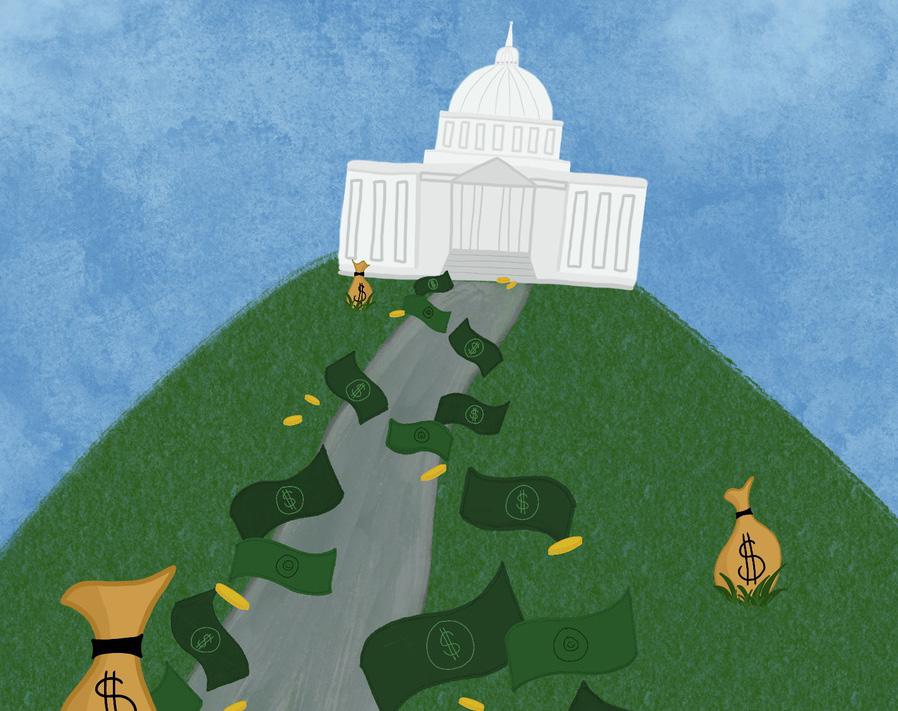
7 minute read
Justice40 Initiative funds climate advocacy in Rhode Island
METRO Officials, community organizers share perspectives on new federal grants
BY JULIA VAZ METRO EDITOR
Advertisement
In January 2021, the Biden administration announced the Justice40 Initiative as part of a series of measures to address the climate crisis. The initiative mandates that “at least 40% of the benefits of certain federal programs must flow to disadvantaged communities” to aid in climate-related issues.
To help implement the policy, the administration launched the Climate and Economic Justice Screening Tool, which “identifies communities that have faced historic injustices and have borne the brunt of pollution” last November, according to a White House press release. The Herald spoke to Rhode Island officials and organizations to understand the initiative’s impact on climate policy in the state.
According to Michael Healey, chief public affairs officer for the Rhode Island Department of Environmental Management, the initiative represents a first in the history of climate policy in the United States.
“Not surprisingly given our nation’s history of racial and other inequality, the United States has never committed to environmental justice on this scale before — or even attempted to,” he wrote in an email to The Herald. Healey added that DEM hopes the initiative will bring resources for “communities (that) have been overburdened by legacy pollution and environmental hazards.”
DEM also hopes to benefit from other environmental justice measures established by the Inflation Reduction Act. Healey wrote that DEM is preparing to apply for an Environmental Justice grant later in the spring. Environmental Justice programs aim to support “government activities that lead to measurable environmental or public health impacts in communities disproportionately burdened by environmental harms,” according to the United States Environmental Protection Agency’s website.
The language on climate justice supported by the IRA and the Justice40 Initiative will also be reflected on DEM’s 2023-2026 strategic plan, Healey explained. The plan will focus on prioritizing “diversity, inclusion and environmental justice in all programs,” he saod. Some of its goals will include the development of a diverse DEM workforce, a strong relationship with residents of underserved communities and the incorporation of environmental justice into grant considerations.
The Herald also spoke to Monica Huertas, executive director of The People’s Port Authority, an organization working to “stop the construction and expansion of fossil fuel facilities near and on the Port of Providence,” according to Huertas. She shared that the PPA was recently awarded a Justice40 grant. “I thought it was a great idea because those federal grants … usually just go to large organizations,” she said.
Huertas added that the PPA’s application for federal funding in 2020 was denied. Between 2021 and 2022, the application was approved, and the organization was provided a grant of roughly $27,000, Huertas said. The funds are being used to mainly support the organization’s Green Justice Zones, which, in underserved communities, aim to “pass … and write legislation … to have people in the community involved in the decision-making process,” according to Huertas.
“They can give us more money,” Huertas answered when asked if she felt there were ways the Justice40 Initiative could improve. For her, funding to local grass-roots organizations is crucial. “Leave it to the community. We know what we are doing, we know what our needs are,” she added.
While April Brown, interim director of the Racial and Environmental Justice Committee of Providence, also praised the initiative, she said that the Justice40 Initiative will not fix all issues around equity impacting local communities. She pointed to how smaller organizations still encounter difficulty when trying to receive federal funding.
“It’s still a challenge to get federally funded,” Brown said, explaining how smaller organizations usually struggle to compete with those that have the personnel and resources to go through a federal application process. She added that funding should also be made available at the state level. “Every state agency should have an equity plan so that the money can get to the communities” with the highest need, she said.
She also expressed concerns over the newly released screening tool. According to Brown, the tool — which uses asthma and lead rates as criteria to identify vulnerable areas — is “not necessarily bringing new information.” For her, it is “not rocket science” that places such as the Port of Providence are in need of assistance and resources. Washington Park, the neighborhood near the port, has one of the highest rates of childhood asthma in Rhode Island, because of pollution from nearby industry, The Herald previously reported.
“I think what will be helpful is when they start doing community engagement and looking at how that information is actually affecting the people who live in those areas,” Brown said.
“One of the challenges of data is that it loses context … if you are not having conversations with the people to understand the impacts, then you are just making guesses … and that’s not good policy-making,” she added.
While Brown is not dismissing the accomplishments of the Initiative, she still identifies areas where it can improve. “I do think people are trying to help … but I do also think there’s still a disconnect” between federal legislators and communities, she said.
For Brown, projects like the Justice40 Initiative must aim to foster a closer relationship between policy-makers and those who be impacted by such policies. “We are already burdened,” she said. “We need (legislators) to let go of some of that burden on us. We need that to happen for equity to happen.” of which will carry over to this year’s budget surplus. Much of that surplus was due to pandemic-related federal aid and was padded by income tax and sales tax revenue that, according to DiPalma, exceeded all forecasts.
Robert Hackey, adjunct lecturer in international and public affairs, said that recent COVID-19 relief from the federal government and higher-than-expected tax revenue has made state surpluses quite common throughout the country.
“Rhode Island has been very conservative in how it used the COVID stimulus funds,” Hackey said. But he noted that the onset of a recession might quickly change the state’s economic situation.
“In a recession, your (state) income drops because fewer people are working, but conversely, your expenditures rise,” Hackey said, referencing Medicaid and other cash assistance programs that more people qualify for in times of economic stress.
Effective relief, or easy way out?
The governor’s budget focuses on providing Rhode Islanders with immediate financial relief, but Hackey said the government may be making a mistake by not considering longterm solutions.
“I don’t think there’s anything, on the one hand, wrong with a tax relief approach,” Hackey said. “But on the other hand, I think some of the things that we’re talking about don’t make a whole lot of sense in terms of a long-term investment.”
Hackey pointed to McKee’s proposed reduction in the Rhode Island sales tax from 7% to 6.85%. While the governor’s press release promises this change will save residents $35 million annually, Hackey said he doesn’t see the reduction as sustainable.
“Rhode Island has historically had some significant structural deficits where we have a mismatch between the revenues that are coming in and our expenditures,” he said. “By cut- ting the sales tax, you’re essentially limiting your revenues going forward,” a change that would have a “multiplier effect” in the future.
Derek Gomes, chief public affairs officer for the Department of Administration’s Office of Management and Budget, wrote in an email to The Herald that the tax cuts keep Rhode Island “competitive” with nearby states. Rhode Island has the highest sales tax in New England, with Connecticut and Massachusetts having sales taxes of 6.35% and 6.25% respectively.
“Approximately one-third of Rhode Islanders live within three miles of the Connecticut or Massachusetts border,” he added. “The Governor is proposing a phased-in reduction to the sales tax rate when economic conditions allow to ensure it is sustainable,” according to the budget’s executive summary.
DiPalma views the state tax reduction as an effort to address what he sees as one of the most pressing concerns in the state: the high cost of living. He said that Rhode Islanders expected a larger reduction than what the budget proposed.
Hackey said that the move doesn’t make the state’s tax climate any more competitive with Massachusetts, though that may have been an aim of the reduction. “If the goal is to try to get more folks to spend more money in Rhode Island versus other states, I don’t think we really accomplish that,” Hackey said.
Hackey also took issue with McKee’s plans to pause the three-cent per gallon increase in the gas tax. He said gas tax revenue pays for the state’s “big to-do list of projects … when it comes to infrastructure, and if we’re not going to generate more state-sourced funds, I think that’s problematic.”
Per the budget proposal, $24.6 million of the state’s surplus will be used to help cover the costs of infrastructure projects while providing Rhode Islanders with tax relief, according to Gomes.
Alternative options, looking ahead Camilo Viveiros, executive direc - tor of the George Wiley Center, challenged the budget for its failure to address the structural and systemic changes he said Rhode Island needs to make. He expressed frustration that the government isn’t focusing on what he sees as key issues: building more government-owned housing, restructuring taxation to be more equitable and funding transportation and education.
“If there’s more resources, there’s also more responsibility to make sure those resources are spent in a way that addresses our basic human needs,” Viveiros said. “It shouldn’t be up to just a small group of people (to) decide how these resources are spent.” He advocated for the government to solicit public input on what they’d most like to see the money spent on.
Viveiros said that he views tax cuts as especially ineffective when it comes to addressing the needs of low-income and working-class people. Viveiros said the lowest bracket of low-income households doesn’t pay taxes due to earned income programs and thus doesn’t stand to benefit from tax reductions.
The George Wiley Center supports a Percentage of Income Payment Program rather than sweeping rebates, according to Viveiros. The model would allow Rhode Islanders to pay bills proportionate to their actual earnings, rather than flat rates that might be affordable for one household but unsustainable for another.
Gomes explained that the budget’s inclusion of measures beyond tax reductions will ensure that Rhode Islanders will receive economic aid. He cited budget initiatives aimed at “raising income for all Rhode Islanders, improving educational outcomes that meet Massachusetts’ levels by 2030 and creating a healthier state where we reduce chronic illness and improve health outcomes.”
The budget proposal’s plan to increase K-12 education funding by $57.8 million, as well as its investment in small businesses and infrastructure improvement projects, will also help make progress towards Gov. McKee’s Rhode Island 2030 goals, according to Gomes.
“Additionally, the State is using the $1.13 billion in State Fiscal Recovery Funds on a number of projects to increase the affordable housing stock, assist sectors that were negatively impacted by the pandemic and support disproportionately impacted communities,” Gomes said.
To Hackey, surplus funds should go towards addressing issues that aren’t typically budget items, such as homelessness, affordable housing and climate change.

“I’d like to see us invest it in ways that pay dividends going forward,” Hackey said.
SINCE 1891







